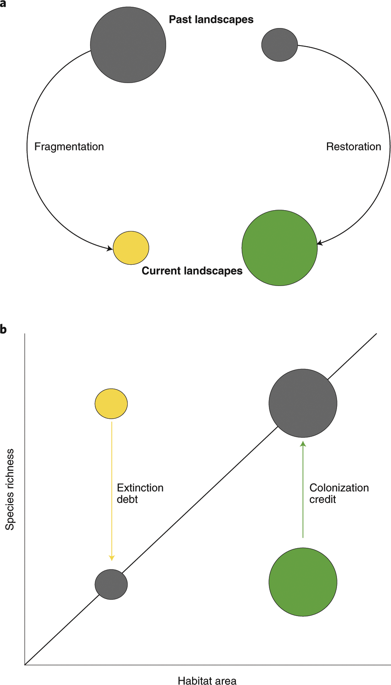当前位置:
X-MOL 学术
›
Nat. Ecol. Evol.
›
论文详情
Our official English website, www.x-mol.net, welcomes your
feedback! (Note: you will need to create a separate account there.)
Ecological time lags and the journey towards conservation success.
Nature Ecology & Evolution ( IF 13.9 ) Pub Date : 2020-01-27 , DOI: 10.1038/s41559-019-1087-8 Kevin Watts 1, 2 , Robin C Whytock 2 , Kirsty J Park 2 , Elisa Fuentes-Montemayor 2 , Nicholas A Macgregor 3 , Simon Duffield 4 , Philip J K McGowan 5
Nature Ecology & Evolution ( IF 13.9 ) Pub Date : 2020-01-27 , DOI: 10.1038/s41559-019-1087-8 Kevin Watts 1, 2 , Robin C Whytock 2 , Kirsty J Park 2 , Elisa Fuentes-Montemayor 2 , Nicholas A Macgregor 3 , Simon Duffield 4 , Philip J K McGowan 5
Affiliation

|
Global conservation targets to reverse biodiversity declines and halt species extinctions are not being met despite decades of conservation action. However, a lack of measurable change in biodiversity indicators towards these targets is not necessarily a sign that conservation has failed; instead, temporal lags in species' responses to conservation action could be masking our ability to observe progress towards conservation success. Here we present our perspective on the influence of ecological time lags on the assessment of conservation success and review the principles of time lags and their ecological drivers. We illustrate how a number of conceptual species may respond to change in a theoretical landscape and evaluate how these responses might influence our interpretation of conservation success. We then investigate a time lag in a real biodiversity indicator using empirical data and explore alternative approaches to understand the mechanisms that drive time lags. Our proposal for setting and evaluating conservation targets is to use milestones, or interim targets linked to specific ecological mechanisms at key points in time, to assess whether conservation actions are likely to be working. Accounting for ecological time lags in biodiversity targets and indicators will greatly improve the way that we evaluate conservation successes.
中文翻译:

生态时滞和保护成功的旅程。
尽管采取了数十年的保护行动,但仍未实现扭转生物多样性下降和物种灭绝的全球保护目标。但是,针对这些目标的生物多样性指标缺乏可衡量的变化并不一定表明保护已失败;相反,物种对保护行动的反应的时间滞后可能掩盖了我们观察保护成功进展的能力。在这里,我们提出了生态时滞对保护成功评估的影响的观点,并回顾了时滞的原理及其生态驱动力。我们说明了许多概念物种可能如何对理论环境中的变化做出响应,并评估了这些响应如何影响我们对保护成功的解释。然后,我们使用经验数据调查实际生物多样性指标中的时滞,并探索替代方法以了解造成时滞的机制。我们提出的设定和评估保护目标的建议是在重要的时间点使用里程碑或与特定生态机制相关的临时目标,以评估保护行动是否可能奏效。考虑生物多样性目标和指标中的生态时滞将大大改善我们评估保护成功的方式。评估保护措施是否可能奏效。考虑生物多样性目标和指标中的生态时滞将大大改善我们评估保护成功的方式。评估保护措施是否可能奏效。考虑生物多样性目标和指标中的生态时滞将大大改善我们评估保护成功的方式。
更新日期:2020-01-27
中文翻译:

生态时滞和保护成功的旅程。
尽管采取了数十年的保护行动,但仍未实现扭转生物多样性下降和物种灭绝的全球保护目标。但是,针对这些目标的生物多样性指标缺乏可衡量的变化并不一定表明保护已失败;相反,物种对保护行动的反应的时间滞后可能掩盖了我们观察保护成功进展的能力。在这里,我们提出了生态时滞对保护成功评估的影响的观点,并回顾了时滞的原理及其生态驱动力。我们说明了许多概念物种可能如何对理论环境中的变化做出响应,并评估了这些响应如何影响我们对保护成功的解释。然后,我们使用经验数据调查实际生物多样性指标中的时滞,并探索替代方法以了解造成时滞的机制。我们提出的设定和评估保护目标的建议是在重要的时间点使用里程碑或与特定生态机制相关的临时目标,以评估保护行动是否可能奏效。考虑生物多样性目标和指标中的生态时滞将大大改善我们评估保护成功的方式。评估保护措施是否可能奏效。考虑生物多样性目标和指标中的生态时滞将大大改善我们评估保护成功的方式。评估保护措施是否可能奏效。考虑生物多样性目标和指标中的生态时滞将大大改善我们评估保护成功的方式。











































 京公网安备 11010802027423号
京公网安备 11010802027423号